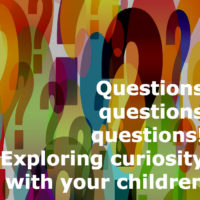On the importance of asking, exploring, and generating questions.
Babies are beautiful, aren’t they? All rolls of soft flesh, wrapped in fluffy cotton, angelic looks, and giggles like nothing else. And then they learn to talk; often the first words are ‘Mummy’ or ‘Daddy’. This (very) quickly develops into ‘Mummyyyyyy?’ and ‘Daddyyyyy…?’: the questions begin. For small children, there is no limit to the number of questions they seem to want to ask, and also seemingly no limits in terms of propriety – anything and everything is fair game. Research by Littlewoods indicated that the average 4 year old asks 288 questions a day. Every. Single. Day.
 So when we first send our precious children off to school – skipping gently in the last of the summer sunshine – mixed with the slight tinge of guilt and sadness at losing a little friend is (dare we whisper it?) a sigh of relief that now we won’t have to answer all those 288 questions. That’s now someone else’s job, from 9 until 3, five days a week. The silence can be almost deafening.
So when we first send our precious children off to school – skipping gently in the last of the summer sunshine – mixed with the slight tinge of guilt and sadness at losing a little friend is (dare we whisper it?) a sigh of relief that now we won’t have to answer all those 288 questions. That’s now someone else’s job, from 9 until 3, five days a week. The silence can be almost deafening.
But a piece of research I read some time back showed that being at school seems to curb these questions: after one term in school, that daily number of questions has dropped on average by 90%. (I feel relief on behalf of the teacher – can you imagine being asked 288 questions a day by 30 children? That’s… a lot of questions.) Part of me hopes that this reduction might be because children are being discouraged from asking the same question several times in quick succession whilst they wait for you to finish your previous sentence: “Mummy, can I have a drink? Can I have a drink, mummy? I’m thirsty, can you please make me a drink?”. I also know that it is simply because they have less one-on-one time in which to ask their questions. Another, smaller, part of me holds my head and worries that their natural curiosity may be being inadvertently crushed in favour of sitting still, listening, and not thinking too much for themselves.
But in some corners of our education system, where the underlying purpose is to strengthen good learning habits, there is hope. Questioning is being encouraged, and trained. Children in these schools may well still ask fewer questions, but those questions will be better directed, more probing. This essential skill can certainly be extended at home, and technology, as it turns out, can be a big help.
The Husband has recently indulged himself by buying yet another gadget for the home: an Amazon Echo. It’s an unassuming speaker with built-in smart voice recognition software which can create shopping lists, play our favourite music at a command, tell us the weather (in case we find ourselves unable to look out of the window), ‘talk to’ the heating system, talk to the smart TV (if we had one), talk to the smart fridge (if we had one)… and, as it turns out, talk to my children. I began to feel slightly inadequate.
 The first evening was spent asking ‘Alexa’ (yes, she has a name. No, I’m not happy about her) to play Coldplay or ELO. Once the novelty of this wore off, the second evening was spent asking her to tell us a joke (which are set to ‘amusing for a 6 year old’ level, happily). But once the six-year-old Girl Child and four-year-old Boy Child realised that Alexa could answer a question, the gloves came off. Suddenly this unsuspecting piece of tech was being bombarded with questions from both my children:
The first evening was spent asking ‘Alexa’ (yes, she has a name. No, I’m not happy about her) to play Coldplay or ELO. Once the novelty of this wore off, the second evening was spent asking her to tell us a joke (which are set to ‘amusing for a 6 year old’ level, happily). But once the six-year-old Girl Child and four-year-old Boy Child realised that Alexa could answer a question, the gloves came off. Suddenly this unsuspecting piece of tech was being bombarded with questions from both my children:
- How tall is a giraffe?
- How big is a rhino?
- How old is the moon?
- What are you doing today?…
I almost felt sorry for her. Almost.
These questions met with varying levels of success. Initially, Alexa sounded like a broken record: “I’m sorry, I didn’t understand the question I heard.” The Boy Child’s first problem was that commands and questions need to be completed within a few seconds of activating Alexa by calling her name. The Boy Child frequently failed, with much umm-ing and aah-ing, to get his questions out in time. So he learned to formulate them in his head before calling her name. My heart lifted a little (for my own sake). His success rate increased drastically.
The Girl Child encountered different problems. Alexa can’t generally answer how ‘big’ an animal is, but she can answer how tall it is, or how much it weighs. She is flakey at answering open questions, but she can answer closed ones: the questions need to be rather narrow and specific. This really helped the Girl Child to think about what it was specifically that she wanted to discover. One of my favourite sights is seeing the moment (and you can often literally see it happening) when the cogs turn, and the piece of information clicks into place, slotting in with the rest of what the child knows. Lightbulb moments are real and fascinating to watch.
The Girl Child and I moved from Alexa (whose limitations in the face of sprawling questions I noted with self-reassuring glee), to the internet. With her newly honed, specific questioning skills, the Girl Child and I searched for and successfully discovered all sorts of information about the moon landings, ahead of her project for this term. Watching her follow her curiosity and discover new horizons was truly exciting.
 And therein lies the crux. Whilst these technologies turn out to be great for training children to generate well-honed, narrow questions, it takes encouragement and enthusiasm to maintain a child’s natural curiosity. Children (heck, all of us) need gentle prodding and probing to raise their eyes from the definitive answer they have been given to the new and expanding horizon beyond. The key is to know that the more answers you get, the more questions are generated. Children should be being encouraged to ask more questions in the face of new knowledge, not fewer. Let’s see if we can make an improvement on that 288.
And therein lies the crux. Whilst these technologies turn out to be great for training children to generate well-honed, narrow questions, it takes encouragement and enthusiasm to maintain a child’s natural curiosity. Children (heck, all of us) need gentle prodding and probing to raise their eyes from the definitive answer they have been given to the new and expanding horizon beyond. The key is to know that the more answers you get, the more questions are generated. Children should be being encouraged to ask more questions in the face of new knowledge, not fewer. Let’s see if we can make an improvement on that 288.


No comments yet.